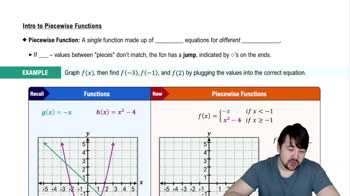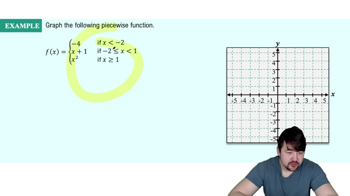Table of contents
- 0. Functions7h 52m
- Introduction to Functions16m
- Piecewise Functions10m
- Properties of Functions9m
- Common Functions1h 8m
- Transformations5m
- Combining Functions27m
- Exponent rules32m
- Exponential Functions28m
- Logarithmic Functions24m
- Properties of Logarithms34m
- Exponential & Logarithmic Equations35m
- Introduction to Trigonometric Functions38m
- Graphs of Trigonometric Functions44m
- Trigonometric Identities47m
- Inverse Trigonometric Functions48m
- 1. Limits and Continuity2h 2m
- 2. Intro to Derivatives1h 33m
- 3. Techniques of Differentiation3h 18m
- 4. Applications of Derivatives2h 38m
- 5. Graphical Applications of Derivatives6h 2m
- 6. Derivatives of Inverse, Exponential, & Logarithmic Functions2h 37m
- 7. Antiderivatives & Indefinite Integrals1h 26m
0. Functions
Piecewise Functions
Problem 51c
Textbook Question
Area functions Let A(x) be the area of the region bounded by the t -axis and the graph of y=ƒ(t) from t=0 to t=x. Consider the following functions and graphs.
c. Find a formula for A(x)
ƒ(t) = {-2t+8 if t ≤ 3 ; 2 if t >3 <IMAGE>
 Verified step by step guidance
Verified step by step guidance1
Step 1: Understand the problem. We need to find a formula for A(x), which represents the area under the curve y = f(t) from t = 0 to t = x. The function f(t) is piecewise, meaning it has different expressions depending on the value of t.
Step 2: Identify the intervals. The function f(t) is defined as -2t + 8 for t ≤ 3 and 2 for t > 3. Therefore, we need to consider two cases: when 0 ≤ x ≤ 3 and when x > 3.
Step 3: Calculate A(x) for 0 ≤ x ≤ 3. In this interval, f(t) = -2t + 8. The area A(x) is the integral of f(t) from 0 to x. Set up the integral: A(x) = ∫ from 0 to x of (-2t + 8) dt.
Step 4: Calculate A(x) for x > 3. In this interval, we need to consider the area from 0 to 3 using the first part of the function and from 3 to x using the second part. First, find the area from 0 to 3: A(3) = ∫ from 0 to 3 of (-2t + 8) dt. Then, add the area from 3 to x: ∫ from 3 to x of 2 dt.
Step 5: Combine the results. For 0 ≤ x ≤ 3, A(x) is the result of the integral from Step 3. For x > 3, A(x) is the sum of the area from 0 to 3 and the integral from 3 to x from Step 4. This gives us a piecewise formula for A(x).
Recommended similar problem, with video answer:
 Verified Solution
Verified SolutionThis video solution was recommended by our tutors as helpful for the problem above
Video duration:
6mPlay a video:
Was this helpful?
Related Videos
Related Practice





